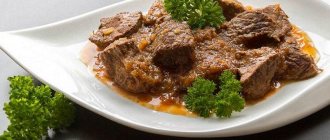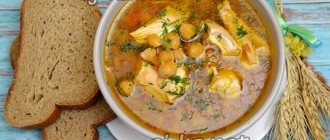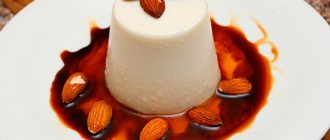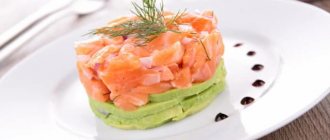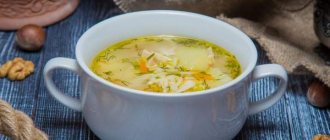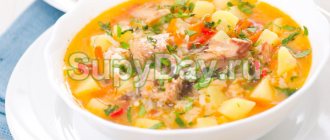When jelly and jellied meat appear on a menu or cookbook, the question naturally arises as to how these two dishes differ. Without going into details, we can say that these are two identical dishes with different names. But in fact, there are quite a lot of differences between them, both in the composition of the ingredients and in the cooking technology.
What is jelly
Jelly is a jelly-like dish thickened in the cold from boiled meat and the broth in which it was cooked. To prepare the dish according to an authentic recipe, be sure to take beef or veal head and legs so that the jelly sets and does not spread, and also has a deep, interesting taste.
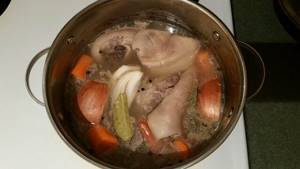
The ingredients for the jelly should be cooked for at least 8 hours.
Jelly in its unchanged form is better known in the northern regions of Russia, where it is prepared according to the cookbooks of the USSR, and always eaten with horseradish. This dish has long been respected by representatives of professions who spend all day outside: hunters, shepherds, fishermen. They can take the jelly with them and consume it either cold or heated over a fire.
LiveInternetLiveInternet
Jellied meat is one of the most popular dishes on the holiday table, and almost every housewife has her own recipe for preparing it. Many people mistakenly call jellied meat jelly, but this is not entirely true. Indeed, both dishes are prepared from meat products, but both the cooking technology and the components used differ. What are the features of preparing jelly and jellied meat, what is the difference between these dishes? What is the difference between jelly and jellied meat? At first glance, the difference is almost invisible. Both dishes are prepared from meat and meat by-products over a long period of time. In both cases, the appearance of the finished dishes will be the same - it is finely disassembled meat, filled with a strong broth, which has congealed due to the high content of gelling substances. However, the foods also have significant differences. Which ones exactly will be indicated below. What is jelly Jelly is a cold meat dish, the preparation of which uses exclusively beef, as well as beef offal.
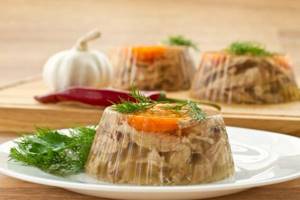
Beef jelly takes much longer to prepare than jellied meat, and the resulting product is not as strong. Its structure is softer. Only garlic is used as a seasoning, and the broth turns out darker due to the long cooking process.
Jellied meat - what kind of dish is this?
Jellied meat is another type of cold meat dish, in the preparation of which several types of meat are used simultaneously. This dish is prepared faster than jelly, and is generously flavored with spices and roots to the hostess’s taste. Otherwise, the dishes under discussion are very similar: the cooked meat is separated into fibers, placed in containers and slightly cooled broth is poured on top. When the liquid takes on a jelly-like appearance, the food can be served. ……………. Difference in cooking technology
Despite a more or less similar set of products, the technology for preparing snacks is significantly different.
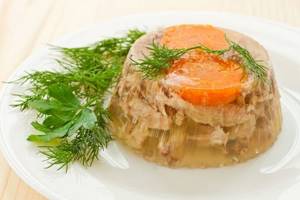
The housewife will need no more than six hours to cook the jellied meat. First, those meat products that contain the most gelatin are placed in cold water - these are ears, shanks, tails, hooves. An hour after the start of cooking, it’s the turn of chopped poultry, pulp on the bone. And an hour before it’s ready, add all kinds of roots and spices to the pan with the rest of the ingredients. After cooking is complete, the meat is removed from the broth and separated into fibers, which are sent to pre-prepared containers. Boiled chopped carrots are sometimes placed on top of the meat. Strain the broth as desired, achieving greater transparency, and pour it over the prepared meat. After this, the jellied meat is sent to the refrigerator to harden. With jelly the situation is somewhat different. First, all its components are soaked in brackish water for several hours, after which they are sent to a pan with cold water at the same time. The jelly is boiled for at least eight hours, most often ten or even twelve, which is why the broth turns out not only dark, but also cloudy. After the cooking time has come to an end, the meat is removed from the broth and separated into fibers. Bring the liquid to a boil again and remove from heat. Then let it cool a little and add grated garlic with beaten egg white. The latter has the property of curling up and absorbing all the debris. The cooled broth is filtered through several layers of gauze, after which it is poured over the previously prepared meat. The dish is sent to the refrigerator to harden.
The resulting jellied meat is more transparent, lighter and harder than jelly.
Differences in product range
One of the most important differences between jellied meat and jelly is the ingredients from which they are traditionally prepared.
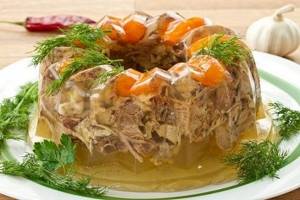
For jellied meat, not only beef is used, but also pork and poultry. As a rule, to obtain a strong, rich broth, parts of animals that are of little use for food and are rich in gelatin are used. Usually these are legs, shanks, ears, brain bones. They contain a large amount of cartilage, which is responsible for turning the broth into jelly. Subsequently, pulp (both pork and beef), as well as poultry, preferably turkey or rooster, are added to the broth being prepared. In addition to this, the use of spices in jellied meat is mandatory. Usually this is bay leaf, allspice, carrots and other additives to taste. This variability allows you to get slightly different tastes of the finished dish each time. Jelly is always cooked only from beef; adding other types of meat is unacceptable. Ears, heads and tails, and drumsticks are often used to prepare this dish. Of the spices, it is permissible to use only garlic. Instead of a conclusion Regardless of which of the dishes under discussion the hostess decided to prepare, there are some rules that should be followed in the preparation of both dishes. It is important to ensure that the broth does not boil too vigorously. This will add unnecessary cloudiness to frozen jellied meat or jelly and make the dish less attractive in appearance. Also, do not constantly stir the food being prepared. The best option for obtaining a clear broth is to remove the resulting foam in a timely manner using a slotted spoon. Both dishes are salted only after the heat under the pan is turned off. This should not be done before - the water constantly boils away, and therefore the jelly or jellied meat may turn out to be over-salted. The water in which the meat is placed is poured into the cooking container only once. It should be exactly twice as much as the meat components. It is strictly forbidden to add water during the cooking process - the finished broth will not have sufficient strength for subsequent solidification. The speed of hardening is also affected by the percentage of fat content of the components included in the jellied meat or jelly. The higher it is, the worse the finished broth will solidify. All ingredients for both dishes must be the freshest. If you use freezing, both dishes will turn out too cloudy. Which is better, jellied meat or jelly, depends on the taste preferences of the hostess and her guests. Recently, the clear boundaries between both dishes are gradually blurring, giving way to imagination and experimentation with both the components of the dishes and the seasonings used.
What is aspic
Jellied meat is a composite dish of meat or poultry, as well as the broth in which they were cooked, with the obligatory addition of spices and vegetables. It is kept in the cold until it completely hardens in the form of jelly. In order for the process to be guaranteed to occur, the recipe calls for preparing the dish mainly from legs, ears, heads, tails - parts of the carcass containing a maximum of gelling substances.
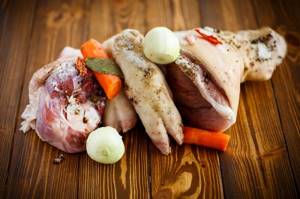
Meat, vegetables and spices for preparing jellied meat can be selected according to your taste
Jellied meat is common in the southern and southeastern regions of Russia, Belarus and Ukraine. In various national cuisines, there are analogues that differ slightly in recipes, spices used and types of meat. For example, in Georgia it is muzhuzhi, in Moldova it is rooster jelly, in Bulgaria it is pacha.
What's good about jellied meat
Meat sausage absorbs the beneficial properties of raw materials, be it chicken or pork. Substances necessary for the body are found in both meat and jelly. Adding various spices can only complement the positive effect. Let's take a closer look.
For women
Probably every woman will sooner or later think about striving for youth. In our search for the best medicine, we may forget that internal factors affect the skin. We are what we eat. Therefore, the food we eat should contain as many nutrients as possible.
The main beneficial component of cold is its protein component, that is, collagen. Everyone knows about its benefits for the skin - it strengthens and smoothes out wrinkles. It is not for nothing that animal collagen is so actively used in the production of creams.
The collagen content in the body decreases with age. As stupid as possible, but the body itself breaks it down with the enzyme collagenase and then works to restore this protein
The older a person is, the lower the ability to restore collagen, so it is very important to supply the body with food.
For men
Cold promotes the growth of muscle tissue through collagen. So, a few tablespoons of cold will work better on your body than a protein bar or drink. Pork cooling relieves the problem of prostatitis, and the presence of zinc in it increases its potency.
If you are pregnant
All meat products have the property of increasing hemoglobin, the normalization of which is important at every stage of life, especially during pregnancy. Decreased hemoglobin levels in the blood can cause anemia
Expectant mothers are especially susceptible to this disease, so it is important to help the body. Hemoglobin is also involved in removing harmful substances from the body, thereby helping to boost immunity
During feeding
During the process of labor and birth of a child, a woman's body experiences a lot of stress, so the mother's nutrition should be very healthy to help her recover. And finally, it is worth remembering that all the nutrients that enter the mother’s body during breastfeeding are transferred through the milk to their children. So why not include cold meats in your diet, which, thanks to its meat base, is rich in nutrients.
A weakened body is susceptible to viral attacks, and lysine contained in the cold can help keep them at bay as it has an antiviral effect. It will also help your body absorb calcium better.
Glycine will help strengthen the immune system, have a beneficial effect on the nerves, calm and relieve tension. Glycine also helps improve brain function.
Collagen restores skin, improves hair and nails, and polysaccharides strengthen bone tissue.
For children
Collagen-containing cold is very beneficial for children, but it is still worth carefully including it in your diet. It should be remembered that cold is difficult food for the stomach, so the child should cook chicken from low-calorie parts of the carcass, and not add spices and salt during cooking. The product must be as fast as possible.
Can you eat cold chicken while losing weight?
Many who decide to eat well and look at their figure refuse such a dish as a cold. And no way. In the end, if you choose the right ingredients for colds, you can get an almost dietary product. Of course, we're not talking about cold pork. But you can enjoy the cold. chicken or turkey and is not afraid that it will affect the figure.
Differences between jelly and jellied meat
Although the differences between jelly and jellied meat are few, they are quite significant. You can use this knowledge both when cooking and show off your erudition in the company of friends. But it is worth considering that in the age of general globalization, boundaries are gradually erased, giving way to culinary experiments. Perhaps soon jelly and jellied meat will become different names for the same dish.
Main differences:
- jelly is prepared exclusively from beef and a certain set of spices, and jellied meat is prepared from any meat products with the addition of seasonings and vegetables;
- jelly is more common in the northern regions of the country, and jellied meat is more common in those located near Ukraine and Belarus;
- before starting cooking, products for jelly must be soaked in cold water and thoroughly cleaned;
- broth for jelly is usually cooked longer - 8-12 hours, in contrast to jellied meat, which requires 6 hours of cooking.
Jellied meat in medicine
For diabetes
Colds in diabetes are not contraindicated (in particular, in the presence of groups 1 and 2 of the disease) if they are prepared from lean meat (preferably chicken legs and lean beef). Adding pork is not allowed.
Important: the glycemic index of cold ranges from 10 to 40 units
In case of pancreatitis
For pancreatitis, doctors recommend eating warm foods - this food is more easily absorbed by the body. Therefore, drinking cold cold is contraindicated because digestion will require more energy from the organs involved in digestion.
Nutrition for illnesses
What you can and can't eat:
cholecystitis. hemorrhoids in case of colitis gout confirmed for gastritis inflammation of the pancreas for diabetes
With gastritis
Since the common cold makes digestion more active, it can only be used by people whose illness is associated with low acidity. It is also worth remembering a few rules: jellied meat should be made from lean meat and without adding spices. The use of colds is contraindicated for gastritis with high acidity.
Gout
Colds are not recommended for people suffering from gout. This disease is caused by the presence of uric acid in the blood, as well as a violation of the metabolism of their derivatives - purine. Meat broth, which is actually cold, can release them, making the situation worse.
Haemorrhoids
Colds are not contraindicated for hemorrhoids. The only condition is that more minced meat is added than during normal cooking.
In the gallbladder
In case of cholecystitis, you should also avoid colds. Contraindications continue to make the product difficult to digest in cases where organs cannot function fully.
Jelly and jellied meat: general points
There are far more similarities in the preparation of jelly and jellied meat than there are differences. This is not surprising, since both dishes are essentially thickened boiled meat in its own broth.
What do jelly and jellied meat have in common:
- the meat for both dishes is cooked at a low boil or on the verge of boiling, with the lid open or slightly open;
- It is periodically necessary to remove foam and fat from the surface of the broth using a slotted spoon, but without stirring the main mass;
- It is customary to salt the broth for both jelly and jellied meat immediately before the end of cooking, or after removing the dishes from the heat;
- water must be poured in advance in the required quantity so that it does not need to be topped up, which will negatively affect the gelling properties;
- Both dishes mainly contain offal - legs, heads, tails, ears and similar not very valuable parts of the carcass;
- It is preferable to take fresh or chilled ingredients, since the use of frozen bones negatively affects the transparency of the food.
What is the difference between jellied meat and jellied meat? Difference between jelly and jellied meat
To avoid confusion: what is the difference between rheumatism and rheumatoid arthritis, the difference in causes, symptoms and treatment
To people who are quite far from cooking, it seems that jelly, jellied meat, aspic are all the same dishes, differing only in the name.
However, cooking jellied meat or jelly is so different from each other that a real housewife would never put them side by side - after all, in fact, these are two completely different dishes.
Unique properties of jelly
Scientists have repeatedly proven that all jelly dishes, such as brawn, jellied meat, aspic, bring enormous benefits to humans. Even in Rus', it was used after a hangover (very important after the holidays). It turns out that the proteins and broth that make up the dish bind the under-oxidized elements of the breakdown of alcohol with aldehydes. As a result, the body is cleansed.
During the period of alcohol intoxication, a person experiences a lack of the vital amino acid – glycine. This substance is responsible for the functional activity of the nervous system and metabolic processes that occur in the brain
The properties of this amino acid reduce the possibility of abrasion of cartilage and bones, and also prevent premature aging of tissues.
Jellied meat has a positive effect on joints, so it is recommended to use it for arthrosis, diseases of the musculoskeletal system, and arthritis.
According to most people, the best natural medicine for these ailments is jellied meat.
The benefits and harms of the dish are undeniable, but frequent consumption of the product can cause significant damage to health, especially for people with similar diseases. Therefore, the benefits of jellied meat for joints are not as great as some people believe.
Chemical composition
Jelly is rich in a special protein – collagen. Its gelatin contains a lot of iron, sulfur, mucopolysaccharides, phosphorus, calcium, carbohydrates, protein, fats and glycine.
Gelatin helps relieve emotional stress, get rid of depression and unreasonable fears. For this reason, jelly is considered a “complete” product.
In addition, gelatin helps fight age-related changes in the skin.
It should be noted that, in addition to the above amino acids and microelements, the deli meat contains a lot of vitamin B. It is responsible for the production of hemoglobin and polyunsaturated fatty acids.
Beef jellied meat also contains retinol (vitamin A). The benefits and harms of jelly are of interest to many, so let’s continue this kind of excursion.
By eating jellied meat, you not only enjoy its taste, but also supply your body with essential microelements and beneficial substances. For example, vitamin A sharpens vision and strengthens the immune system. Lysine (amino acid) contained in the dish has an antiviral effect and helps better absorption of calcium.
Jelly (jellied meat): the benefits and harms of a delicacy
Much has been said about its beneficial properties. Now let's add a fly in the ointment. The disadvantage is the high cholesterol content, as well as high calorie content.
Abuse of this dish can provoke the formation of atherosclerotic plaques, which can lead to heart pathologies.
The abundance of garlic and spices that season the jelly puts a huge strain on the liver and blood vessels.
Classic jelly recipe
The jelly takes a long time to prepare, but the result is worth it. The main thing for everything to work out is to strictly follow the recipe.
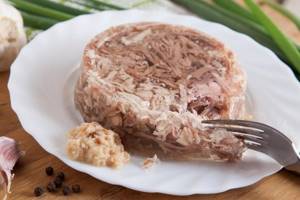
Classic beef jelly
Ingredients:
- beef head and 4 shanks;
- onions – 2 pcs.;
- parsley root - to taste;
- bay leaf – 3 pcs.;
- garlic – 1 pc.;
- black peppercorns - to taste;
- salt - to taste;
- vinegar – 1 tsp.
We scorch the beef offal, chop it into small pieces and soak in clean chilled water for a couple of hours. We rinse them thoroughly, clean them if necessary, put them in a large container - a saucepan or basin, based on the fact that you need to fill everything with water, a volume twice as large as the meat itself. We also put onions, garlic, parsley, bay and pepper there. Cook everything for about 8 hours over low heat, promptly removing any foam that appears. We take out the beef, separate the meat and chop it finely, and send the bones back into the broth to cook for another couple of hours.
After the broth has evaporated to such an extent that it becomes approximately the same volume as the meat, add some salt and vinegar, quickly bring to a boil and turn off the heat. Separate the liquid from the rest of the mass and filter so that the jelly is transparent, without solid particles.
Place the meat in low ramekins or a large bowl and pour the broth evenly. Let it harden in the refrigerator or, in the cold season, outside. Serve with horseradish and mustard.
Classic beef jelly
What is the difference between CT and MRI? indications and contraindications
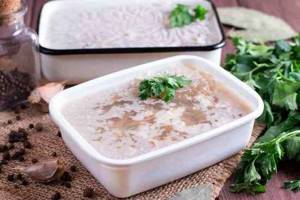
There are an incredible number of recipes for jellied meat, which cannot be said about jelly. Here is a classic version of beef with carrots and eggs. The dish turns out incredibly tasty and beautiful, perfect for a festive table. If you don’t like the additives, you can exclude them and leave only the meat and broth with spices.
Ingredients
- 3.5 kg of beef on the bones; 2.4 liters of water; 1 head of garlic; 2 laurels; 2-4 eggs; 1 onion; 1 carrot; 5 peppercorns; 1 clove; salt to taste; greens for decoration.
Cooking method
Soak the meat for an hour in cold water, the liquid will turn pink, then rinse the beef. Pour in the recipe water and put it on the stove to cook. When boiling, collect all the foam. Sometimes the jelly is cooked in a second broth. You can drain the first water and refill it. Cook the meat at low simmer for 4 hours. Then we throw in one onion, maybe with the peel on, add laurel, cloves, peppercorns, and washed carrots. Simmer for another 2-3 hours. At the end, salt the meat and broth. It is not recommended to do this in the past. Remove the meat and cool. Strain the broth through cheesecloth or cloth. We taste, add salt or pepper, and make it to your liking. Remove the meat from the bones, break it into pieces with your hands or cut it. Chop the garlic, mix with the meat, place in bowls, pour in broth so that it slightly covers the meat. Place in the refrigerator until the top hardens slightly. Boil the eggs, peel the carrots and chop them. Place on the frozen meat, pour over the remaining broth. For beauty, you can add a little greenery, throw in peas or corn. Place the jelly in the refrigerator and leave for at least eight hours.
Since jelly is prepared exclusively from beef, it can be placed on the Muslim table, and can be safely given to children and those people who do not like fatty foods. Jellied meat is much higher in calories, but it has its own advantages and differs in taste. In any case, both dishes are worthy of taking up space on the table.
Classic jellied meat recipe
Jellied meat allows the housewife to use her imagination when preparing, replacing types of meat, spices and vegetables to her taste. Therefore, each time the dish will be slightly different from the previous version.

Jellied meat with carrots and boiled eggs
Ingredients:
- pork leg – 1 pc.;
- beef shoulder – 0.5 kg;
- carrots – 2 pcs.;
- onions – 2 pcs.;
- bay leaf – 3 pcs.;
- garlic – 1 pc.;
- parsley root – 50 g;
- black peppercorns – 10 pcs.;
- salt - to taste.
We wash the meat, if necessary, then additionally clean it of bristles and other things, put it in a saucepan, and add onions, onion peels, peeled carrots, and parsley roots. In this case, onion peels are used to give the broth a beautiful, slightly golden color. If you want it to be transparent or close to it, then we throw out the husk.
Fill the prepared products with water 3-5 cm above their level, bring to a boil, then reduce the heat and cook at the brink of boiling for 6 hours. An hour before cooking, add pepper and bay leaf.
At the end of cooking, strain the broth, for example, through gauze folded several times, to prevent the ingress of boiled seasonings and debris, as well as to ensure the most transparent consistency. Separate the meat from the bones, separate it into fibers and cut into small pieces. Chop the garlic and mix with the meat; add chopped boiled carrots if desired.
We transfer the prepared products into molds or into one large form. Salt the broth, pour it over the meat and vegetables. Let it stand for half an hour at room temperature and send it to finally harden in the refrigerator for 8-12 hours.
Classic recipe for beef jelly with spices (with gelatin)
Jellied meat in the classic version is prepared quite simply - the meat is boiled with the addition of spices, and at the very end dissolved gelatin is added to the broth.
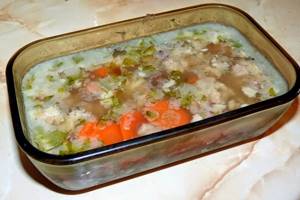
For this recipe, it is best to use meat on the bone, since bone tissue contains gelling agents. As a result of prolonged cooking, they pass into the broth, turning the latter into jelly. However, meat broth is not always strong; in this case, gelatin will help. This is a natural component, thanks to which the jelly will quickly harden.
Ingredients:
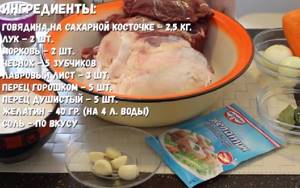
- Wash the meat well under running water. Let's prepare the vegetables: peel the onions, carrots, and garlic cloves.
- Place the meat in a 7-8 liter pan and fill it with water (so that the meat is completely covered with liquid). As soon as the broth begins to boil, be sure to remove the foam so that our jellied meat turns out clean and transparent as a tear. Then reduce the heat to very low and cook for 5 hours, almost simmering under the lid.
- Then add vegetables (whole onions and carrots), add garlic and season with peppercorns. Continue cooking for another hour on low heat under the lid. It is better to remove all the fat formed during boiling if you want to get a more dietary dish.
- 20 minutes before the end, add salt to taste and add bay leaf.
- After turning off the stove, let the broth cool slightly and remove the meat and vegetables from it.
- We separate the meat into fibers with our hands, separating it from the bones so as not to miss small chips of the bones. You can also cut it into small pieces with a knife.
- Strain the broth through a sieve or double-folded gauze.
- If the broth is not too rich, add gelatin to it. Instant gelatin is very convenient, which is taken at the rate of 1 tablespoon per 1 liter of broth. Next, stir with a ladle so that the gelatin crystals dissolve. Place the pan back on the heat until it reaches almost a boil.
- Place the meat in filling molds and add a little broth. Decorate the top with circles of boiled carrots and any greens.
- After cooling to room temperature, place the molds in the cold (in the refrigerator) and let the meat harden. Serve the finished jelly with mustard, horseradish and other types of sauces. Bon appetit!
Video: facts about jellied meat (jelly)
Tags:
Share on social networks:
You might be interested in reading:
- Ideas for a romantic dinner on March 8th. How to make an unforgettable romantic dinner by candlelight, for two, at home and what to cook
How to choose the best green tea and how to brew it correctly. The best recipes for brewing green tea: with milk, lemon, jasmine, honey and ginger
How to make delicious mulled wine at home from red wine. Classic mulled wine recipes; non-alcoholic mulled wine in a slow cooker; summer camping mulled wine.
How to properly and quickly cook Chinese wok noodles at home? The best wok noodle recipes with descriptions and photos.
Differences in product range
One of the most important differences between jellied meat and jelly is the ingredients from which they are traditionally prepared.
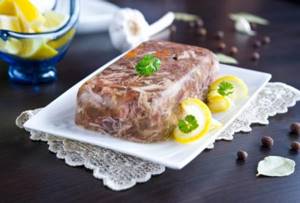
- For jellied meat, not only beef is used, but also pork and poultry. As a rule, to obtain a strong, rich broth, parts of animals that are of little use for food and are rich in gelatin are used. Usually these are legs, shanks, ears, brain bones. They contain a large amount of cartilage, which is responsible for turning the broth into jelly.
- Subsequently, pulp (both pork and beef), as well as poultry, preferably turkey or rooster, are added to the broth being prepared.
- In addition to this, the use of spices in jellied meat is mandatory. Usually this is bay leaf, allspice, carrots and other additives to taste. This variability allows you to get slightly different tastes of the finished dish each time.
Jelly is always cooked only from beef; adding other types of meat is unacceptable. Ears, heads and tails, and drumsticks are often used to prepare this dish. Of the spices, it is permissible to use only garlic.
Preparing jelly
Jelly is a Russian dish made from leftover meat. It is made from beef meat, so it does not freeze as tightly as jellied meat. Bony parts are suitable for cooking: head, tail, legs.
They must be soaked in a salty solution before cooking. Cooking time is longer about 10-15 hours. After the broth boils, skim off the foam, cover with a lid and simmer over low heat. Only garlic is suitable as seasonings and spices.
It can be finely chopped or crushed using a garlic press. When the meat is cut into pieces, garlic is added. Let the broth sit for 1 hour, then strain.
After all, they should pour the meat, disassembled into pieces. This broth is clarified using egg white and lemon juice.
Features of the filler
The method for preparing aspic is almost the same. The meat is poured with cooled, strained broth.
Any meat can only go into aspic:
- Fish.
- Birds.
- Beef.
- Pork.
- Beef or pork tongue.
For cooking, lean meat is used, so gelatin is needed for the jelly-like mass. It can be diluted on the basis of vegetable or meat broth. Because of this, it hardens much faster than jellied meat and jelly.
The meat is placed on the bottom of the container in pieces. Various vegetables are laid out on top, which will be visible through the jelly. Sliced cucumber slices, eggs, carrots, and green peas are suitable as vegetables. You can add dill and parsley to taste.
Another cold dish is brawn. It is made from different parts of the carcass, has less broth than jellied broth, and jelly. When the meat is disassembled and filled with broth, it is cooled and placed in a casing.
As with preparing any dishes, there are useful tips and recommendations for cold dishes to ensure that the dish turns out tasty and appetizing:
- It is not recommended to use frozen meat for preparing jellied meat, aspic and jelly. Because of this, the broth may become cloudy, which cannot be eliminated.
- Do not use very fatty meat, the dish will not freeze well.
- It is necessary to salt the broth after it is cooked, otherwise it can be over-salted as the water boils away.
- You should not allow the broth to boil strongly; it is better to cook over low heat without stirring it. The foam should be removed regularly. The result will be a clear broth.
- It is advisable to pour chilled water, 2 times more than meat. It is not advisable to add it during cooking.
Recipes for jellied meat, aspic and jelly
In folk cuisine there are many different recipes for cold dishes, among which jellied meat, aspic and jelly are popular. Let's look at the recipes given in the table.
| Name | Recipe |
| Jellied meat according to Georgian recipe | Pre-soak 5 pork legs in water, scrape and peel. Place them in a deep saucepan, add the onion and bay leaf. Pour in cold water, bring to a boil, descale. Strain the broth and pour it over the meat. You can add chopped herbs and lemon juice to it. Refrigerate to harden. |
| Jelly according to an old recipe | Chop one veal head, rinse and place in a saucepan. Add some beef fillet. Add carrots, parsley, onion, celery. Pour water 10 cm above the meat. After boiling, remove the scale and cook for about 8-9 hours. After about an hour of cooking, remove the vegetables from the broth. Remove all bones from the meat, garnish with vegetables, and pour in strained broth. To lighten it, add lemon juice. Place in a cool place to form a jelly mass. |
| Chicken aspic | Stir gelatin in cool water and leave to swell for 2 hours. At this time, boil the chicken fillet. Separate the meat from the bones and place in a container. Decorate it with carrots, cucumbers and herbs. Pour the broth along with gelatin on top of the meat. Leave the aspic to cool in the cold. |
- Related Posts
Jellied, jelly and jellied meat
- These are cold table dishes that belong to the same category and have a lot of similarities in preparation. But still, these are different foods. What is the difference between aspic, jelly and jellied meat, we will find out further.
Jellied is a cold appetizer dish, the basis of which can be the meat of animals, birds, fish, filled with clear broth. To harden the dish, special gelling agents are used, in particular gelatin. The broth is often clarified and made transparent using special pulls. In addition, it is tinted by adding various spices. In addition to meat or fish and broth, the aspic contains figuratively chopped vegetables.
When preparing aspic, the aesthetic component is very important. All products must be cut extremely carefully. Vegetables are often given some form. Carrots, for example, are used to form very original flowers. The broth should be a nice color. In addition, it must be transparent so that all the components of the filler in it are clearly visible.
Aspic belongs to French cuisine, but its prototype was Russian jelly, which French chefs “ennobled”, creating, in fact, a completely new dish.
Jelly is a rather fatty, congealed broth with pieces of meat and offal. In this case, we are not talking about aesthetics. The broth turns out to be quite cloudy and not as attractive as the broth in aspic. Meat and offal are randomly divided into pieces.
Most often, jelly is made from beef, less often from veal. In addition, such a tasty, but not appetizing in appearance, dish is prepared on the basis of pork. By the way, it is this version of jelly that is called jellied meat. It is most common in Ukraine and those regions of Russia that border Ukraine.
Jellied fish can also be called fish frozen in its own broth. However, in order not to be confused in terms, this version of the dish is most often called cold.
The difference between aspic, jelly and jellied meat is obvious. Jelly is a prototype of other similar dishes. Jellied meat is the same as jelly, only it is prepared not with beef, but with pork. But aspic is a more aesthetically designed version of jelly and jellied meat.
Description of preparation:
Jelly is an old Russian dish, without which not a single feast would be complete. Traditionally, jelly was prepared for Christmas and Epiphany, when the slaughter of livestock began with the onset of cold weather. Jelly is a thickened, chilled meat (or fish) broth with pieces of meat (or fish). Jellies are prepared from lamb, pork, beef (legs, head, ears, lips), as well as fish and poultry offal. The cooking principle is that meat products with a large amount of connective tissue turn into jelly when cooked. Initially, Russian jellies were cloudy, colorless and unattractive, but French chefs introduced lightening and tinting the broth with spices, which gave the dish a new flavor. In Russian cuisine, garlic was always added to jellies - it not only imparted a piquant aroma, but also kept the dish fresh longer. The jelly is served with mustard, horseradish, kvass or sauce. Purpose: For lunch / For dinner / For the holiday table / New Year / Christmas Dish: Appetizers Geography of cuisine: Russian cuisine
What do aspic and jelly have in common?
What is common to jellied meat and jelly is that both of them belong to the category of cold meat dishes, are considered traditional for Russian cuisine and are very often used in holiday menus. There are several nuances that are important to observe when preparing one or another dish:
- Do not allow the liquid to boil violently and constantly stir the liquid - you just need to remove the formed foam in a timely manner with a slotted spoon;
- you need to salt the contents of the pan only after cooking;
- water cannot be added during the process - it is poured once in an amount twice as large as the meat ingredients;
- All ingredients must be fresh - if you use frozen ones, the broth will turn out cloudy.
Classic brawn
Another favorite and home-made dish is brawn. It comes from Germany, although it is known by other names in different countries. Saltison is the same brawn, only from less-demanded parts of the carcass and with less jelly broth. When the filler is disassembled, filled with base and hardened a little, it is placed in the shell under a press and sent back to set. The most delicious and popular brawn is in a natural casing, but our housewives have become adept at preparing it in an artificial casing, for example, in a baking bag. The principles of its preparation before pressing are absolutely identical for jellied meat or jelly.
Features of cooking at home
Recipes for making aspic, jelly and jellied meat number in the thousands. They are so diverse that it is sometimes difficult to decide which recipe to use to prepare one of these dishes at home. There are so many professional and amateur cooks, so many different recipes, as well as all sorts of cooking tricks. Of course, it will not be possible to list all the nuances in one article, but we will introduce you to some of them.
Aspic, as mentioned earlier, is prepared using gelatin, which you need to know how to prepare correctly. First, it is filled with cold water and left to swell for a while. Then the swollen gelatin is introduced into the broth. The broth continues to be heated until the specified gelling agent dissolves.
A small amount of broth with gelatin is poured into the molds, after which they are sent to the refrigerator to harden. Then the meat or fish and vegetable components of the aspic are beautifully laid out on a layer of frozen broth, after which they are filled with the rest of the still liquid broth. The dish is sent back to the refrigerator. As soon as it hardens, it can be served.
We will not dwell on the issue of proper preparation of clear broth for aspic, since it is described in detail in the corresponding section of the site.
To bring one of the jelly recipes to life at home will require at least 6-8 hours of free time. The main process is boiling the head (including the tongue and brain), as well as the hooves. Boil the broth with the addition of onions, dill and spicy roots. The liquid is boiled until its volume is equal to the volume of meat products. Then the broth is salted for the first time. The meat and bones are removed. The broth is filtered through cheesecloth. The meat separated from the bones is placed in special molds. Only then are they poured with strained broth. Next, the jelly needs to be sent to a cold place to harden. The use of additional gelling agents is not required. In general, jellies recipes are quite simple, but require a lot of time.
Making jellied meat at home is similar to making jellied meat, the only difference being that jellied meat is made from pork, not beef.
